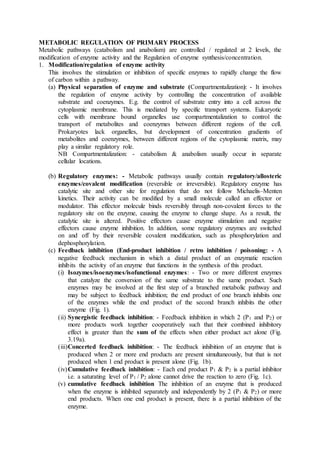
BCH 803 Part 3.docx
- 1. METABOLIC REGULATION OF PRIMARY PROCESS Metabolic pathways (catabolism and anabolism) are controlled / regulated at 2 levels, the modification of enzyme activity and the Regulation of enzyme synthesis/concentration. 1. Modification/regulation of enzyme activity This involves the stimulation or inhibition of specific enzymes to rapidly change the flow of carbon within a pathway. (a) Physical separation of enzyme and substrate (Compartmentalization): - It involves the regulation of enzyme activity by controlling the concentration of available substrate and coenzymes. E.g. the control of substrate entry into a cell across the cytoplasmic membrane. This is mediated by specific transport systems. Eukaryotic cells with membrane bound organelles use compartmentalization to control the transport of metabolites and coenzymes between different regions of the cell. Prokaryotes lack organelles, but development of concentration gradients of metabolites and coenzymes, between different regions of the cytoplasmic matrix, may play a similar regulatory role. NB Compartmentalization: - catabolism & anabolism usually occur in separate cellular locations. (b) Regulatory enzymes: - Metabolic pathways usually contain regulatory/allosteric enzymes/covalent modification (reversible or irreversible). Regulatory enzyme has catalytic site and other site for regulation that do not follow Michaelis–Menten kinetics. Their activity can be modified by a small molecule called an effector or modulator. This effector molecule binds reversibly through non-covalent forces to the regulatory site on the enzyme, causing the enzyme to change shape. As a result, the catalytic site is altered. Positive effectors cause enzyme stimulation and negative effectors cause enzyme inhibition. In addition, some regulatory enzymes are switched on and off by their reversible covalent modification, such as phosphorylation and dephosphorylation. (c) Feedback inhibition (End-product inhibition / retro inhibition / poisoning: - A negative feedback mechanism in which a distal product of an enzymatic reaction inhibits the activity of an enzyme that functions in the synthesis of this product. (i) Isozymes/isoenzymes/isofunctional enzymes: - Two or more different enzymes that catalyze the conversion of the same substrate to the same product. Such enzymes may be involved at the first step of a branched metabolic pathway and may be subject to feedback inhibition; the end product of one branch inhibits one of the enzymes while the end product of the second branch inhibits the other enzyme (Fig. 1). (ii) Synergistic feedback inhibition: - Feedback inhibition in which 2 (P1 and P2) or more products work together cooperatively such that their combined inhibitory effect is greater than the sum of the effects when either product act alone (Fig. 3.19a). (iii)Concerted feedback inhibition: - The feedback inhibition of an enzyme that is produced when 2 or more end products are present simultaneously, but that is not produced when 1 end product is present alone (Fig. 1b). (iv)Cumulative feedback inhibition: - Each end product P1 & P2 is a partial inhibitor i.e. a saturating level of P1 / P2 alone cannot drive the reaction to zero (Fig. 1c). (v) cumulative feedback inhibition The inhibition of an enzyme that is produced when the enzyme is inhibited separately and independently by 2 (P1 & P2) or more end products. When one end product is present, there is a partial inhibition of the enzyme.
- 2. (i) Sequential feedback inhibition The inhibition that is produced when one or more end products inhibit an enzyme in a metabolic pathway and the metabolite that accumulates as a result of this inhibition then inhibits the first enzyme in the sequence and thereby shuts off the entire pathway (Fig. 1d). Fig. 1 Examples of feedback control of branched pathways (e = enzymes; I = intermediates; P=end-products and the broken lines are the paths of inhibition). 2. Regulation of enzyme synthesis/concentration Concentration of enzyme is determined by its rate of synthesis [regulation of gene expression via DNA replication, transcription (e.g. enzyme induction, enzyme repression), translation (e.g. enzyme modulation/attenuation)], rate of dilution, and the rate of inactivation/degradation by proteases. However, it is enzyme synthesis that generally plays the most important role in regulation. It is a coarse tuning mechanism, as opposed to the fine tuning provided by regulatory enzymes, and is more difficult to reverse. Some enzymes are constantly synthesized and are constitutive components of the cell, whereas others are synthesized only when required. Even the constitutive enzymes are produced at different concentrations, as some genes are more highly expressed than others. The expression is controlled by the strength of their gene promoter. Synthesis of catabolic enzymes is controlled by induction (control of transcription), as it is efficient for them to be synthesized only when their substrates are present. E.g. induction of β-galactosidase by E. coli in Lac Operon Synthesis of anabolic enzymes is controlled by repression (feedback inhibition of transcription). NB Feedback inhibition by allosterism produces more immediate effect. E.g. ten enzymes of histidine biosynthesis Enzyme synthesis may also be controlled by a mechanism called attenuation/modulation (control translation). Tryptophan biosynthesis, which involves an operon of 5 enzymes, is coordinated through both repression and attenuation. Prokaryotes and eukaryotes protein/enzyme synthesis is controlled at transcription and translation respectively.
- 3. Sites of regulation of Prokaryotes: usually at transcription initiation Sites of regulation of Eukaryotes: can be at anywhere Mechanism of gene regulation Pathway Terminology Ligand Regulator Catabolic Induction Substrate Negative (lac operan) Positive (ara operon) Anabolic Repression Product Negative (trp operan) Positive (amino acids in yeast)